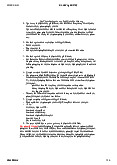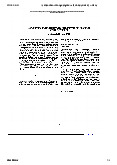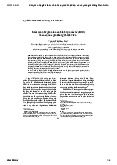





Preview text:
21:39 1/8/24 Article Interdiscursivity 2015 Interdiscursivity
MARIAELENA BARTESAGHI and CHAIM NOY
University of South Florida, USA
Interdiscursivity refers to the heterogeneity of texts, how they fold within them other
texts, other utterances, and draw upon multiple discoursal contexts. By taking up the
productive interaction between text and discourses, the concept of interdiscursivity
proposes an examination of how, on the one hand, discourse is typified and ordered
into more or less permeable or hybrid genres, and, on the other, how genres are pre-
scriptively bound to accountable social action across multiple sites.
Building on Bakhtin’s understanding of communication as inherently dialogic, con-
stitutive of social life, and essential to its historical coherence, interdiscursivity supple-
ments the transdisciplinary vocabulary of situated accomplishments and rich descrip-
tions of single instantiations. By dislocating terms from the ethnography of commu-
nication and its cognate disciplines in the anthropological tradition, as, for example,
“speech event” or “verbal performance,” it proposes a way to examine linkages in social
action (as text) through space, time, and social structuring (such as ideology). The
Bakhtinian grounding of interdiscursivity is therefore important in two ways. First, it
underscores the polyphonic nature of communication or the multiple and heterogeneous
voices within a given (isolatable) occasion of interaction. The functional-informational
model, according to which communication is seen as the transfer of information from
addressor to recipient, is complicated (and rendered more adequate to the analysis of
real-life interactions) when it is acknowledged that the message is neither a singular
noun nor a unified construct. Any utterance is polysemous, that is, having multiple
potential meanings and, consequentially, the simplistic notion of “addressor” and “re-
cipient” cannot stand. Second, interdiscursivity is concerned with the history —or even
historicity —of all texts and utterances. If utterances are suffused or absorbed in time,
then they are always “geological” in character that is, semiotically layered— with layers
added, or eliminated, historically.
Intuitively, interdiscursivity builds on the notion of intertextuality, precisely in the
same way that a discourse may be understood as a complex assemblage of simulta-
neous and chained linguistic acts, designating a larger field—and an interrelationship
across fields of action—than does a text. As Silverstein (2007) puts it, intertextuality
and intertexts “are generated in events of communication through techniques of inter-
discursivity” (p. 7, emphasis added). Much like intertextuality, the concept of interdis-
cursivity is theorized at the juncture of several disciplines that study language as social
action, with the term appearing in discourse studies (discourse analysis [DA] and, from
critical linguistics, critical discourse analysis [CDA]) as well as linguistic anthropol-
ogy, the ethnography of communication, sociolinguistics, and folklore. But a glance
The International Encyclopedia of Language and Social Interaction, First Edition.
Karen Tracy (General Editor), Cornelia Ilie and Todd Sandel (Associate Editors).
© 2015 John Wiley & Sons, Inc. Published 2015 by John Wiley & Sons, Inc.
DOI: 10.1002/9781118611463/wbielsi093 about:blank 1/6 21:39 1/8/24 Article Interdiscursivity 2015 2
IN T E R D I S C U R S I V I T Y
at how interdiscursivity is employed explicitly and proficiently to advance empirical
claims yields mixed, if interesting, results. In the special issue of the Journal of Linguistic
Anthropology dedicated to interdiscursivity (2005), for instance, the concept is at times
treated as synonymous with intertextuality, and at other times is not central, or well-
defined. Alternatively, those discussions that are not directly related to interdiscursiv-
ity, but rather to the notions of voice, register, semiosis, and even narrative, indirectly
reflect on interdiscursivity, perhaps evidencing its broad and fuzzy implications for the
analysis of naturally occurring acts of communication. Also interesting is how, in the
itself porous domain of discourse studies, explicit treatments of the term fall within the
purview of critical discourse analysis, and therefore concerns with hegemony, ideology,
power, and a preference for analyses of written texts over conversational exchanges.
In order to problematize this state of affairs, the empirical illustrations provided here
bridge different disciplines, methodological approaches, and combine both written and spoken utterances.
The analysis of interdiscursivity as the dialectical relations between texts, discourses,
and the realm of the social may be fruitfully undertaken by means of three related con-
cepts. The first is that of ordering, or orders of discourse, which proposes a way of seeing
how semiotic aspects within discourses are employed in dynamics of social legitima-
tion. Discourse types are bound to particular institutional settings or spheres of social
life (as, for example, academic, news, medicine, and so on). Because what “typifies”
them are conventions, it is interesting to ask how these conventions work in a particular
domain. Consider psychotherapy as a discourse, as well as an activity type. As com-
pared to a more (at least at the surface) well-defined questioning activity, as might be a
police interrogation, what counts as doing psychotherapy may be largely heterogenous,
for a clinical exchange may include various semiotic resources and blur the bound-
aries between the discursive orders of private confession, education, intervention, and
psychiatry, to name a few. How this might occur is exemplif ied in the following extract,
a session between T (the therapist) and C (the mother of a 5-year-old boy): (1) Bartesaghi (2005, p. 143) 01 01 T:
Is he mean to people (.) or LEAVE ME ALONE? 02 02 C: Sometimes. 03 03 T:
So he sounds more irritable than depressed.
By first, creating a hypothetical utterance in the informal register, second, attributing
it to the boy as reported speech recontextualized from what one may imagine is the
home, or school, or a domain of experience not actually witnessed by the therapist,
third, comparing this utterance to “mean,” or another category of attributed and puta-
tively dissimilar behavior presented in an informal register (all in line 1), the therapist
is able to secure what in line 3 his uptake suggests is enough of an admission on the
mother’s part (line 2). T can now move to legitimate the beginnings of a therapeutic
diagnosis. T hus, by means of prof iciency in multiple discursive orders that are “therapy,”
such as child speech, reported speech, home, the playground, parent–child interaction,
the diagnostic, the therapist is able to access and realize what lies behind “sounds”: an
institutional and intertextual order of signification. about:blank 2/6 21:39 1/8/24 Article Interdiscursivity 2015
IN T E R D I S C U R S I V I T Y 3
As orders of discourse with a stable set of conventions, genres (such as a commer-
cial, a dissertation, a scientific article, an interview) —which is the second relevant
concept —are “the drive belts from the history of society to the history of language”
(Bakhtin, 1986, p. 65), for changes in the way they are produced and consumed signal
changes that are both linguistic and social. Fairclough’s (2003) discussion of genres
and how these may be chained is particularly good, especially with respect to his focus
on how genres are bound to activity types, thus constraining options for the discursive
performance of social life. As social members acknowledge and avail themselves of
genre conventions, they employ strategies of interdiscursivity, to both af f iliate with
discourse communities by competent use of these strategies, and to exploit sequences
in a chain for their own purposes. Applicants to a tenure track university position, for
example, may compose application letters in accordance with academically ratified
identities of the productive teacher-scholar, listing their accomplishments in conven-
tional ways. By making proper use of this genre, they draw from what comes before
in the chain, to secure what comes af ter, namely, the positive uptake of the hiring
committee. This also means that applicants are counting on the committee’s rewarding
them for appropriate use of conventions by ironicizing them and being willing to “see” beyond them.
Noting that professional communities are discourse communities held together by
conventions of writing, Berkenkotter’s (2001) study takes on psychotherapeutic writ-
ing as a professional exemplification of genre systems, that is, intertextual chains that
both constitute and are constituted by institutional practices. Much like the sociol-
ogy of science’s study of the assemblage of texts, practices, and human and nonhuman
agents in the production of scientific findings, the notion of genre system interdis-
cursively links intertexts and practices; it seeks to show how institutional genres are
recontextualizations of the everyday activities that perform institutional life. The subject
of Berkenkotter’s piece is the recontextualization of therapists’ notes from a clinical ses-
sion into a diagnostic protocol, and the intertextual linkages and interdiscursive strate-
gies involved in these transformations. The heterogeneous therapeutically produced
diagnostic text, she argues, starts as a fuzzy problem account composed of a multi-
plicity of blended, explicit, and elided voices, and discourse types in text–context rela-
tionships that are reformulated into ordered and bounded therapist-driven discourse
for therapist-designated institutional goals. Berkenkotter’s point, that the text–context
relationship is misunderstood if taken in terms of a container metaphor, is well taken.
Rather, she suggests that interdiscursivity be used as a productive tool to study the “com-
plex, historically mediated text/context relationships” (2001, p. 343).
By way of discourse analysis and membership categorization analysis, Bartesaghi
and Bowen’s (2009) study of interviews with Jewish Holocaust survivors introduces
the third concept, hybridity. History, the authors claim, is a metadiscourse made up
of several other discourses that are collaboratively produced in intertexts, such as inter-
views, questioning protocols, and documents of various kinds. By means of an analysis
of how interview questions acquire Jewish respondents capable of re-membering the
Holocaust, thus granting them the status of survivor and their answers that of Holo-
caust memory, Bartesaghi and Bowen show how Holocaust interview questions are about:blank 3/6 21:39 1/8/24 Article Interdiscursivity 2015 4
IN T E R D I S C U R S I V I T Y
pragmatically complex, multifunctional, and layered. Questions are at once conversa-
tional and informal, intimate and therapeutic, terse and directive, asking respondents to
remember facts and dates that are interruptive to the narrative itself as well as not part
of their own evaluation, and drawing on psychocognitive notions of trauma in order
to “re-member” (as in piece together) an already known correct historical timeline.
Interviewers’ deployment of various discursive styles, registers, and institutional objec-
tives folded into utterances that are grammatically structured as uniquely designed and
personal are evidence of how hybridity functions to constrain respondents’ (correct)
answers, while giving the impression of encouraging their own story.
Wodak’s discourse-historical approach (in Wodak & Meyer, 2001/2005) is an eclec-
tic, methodologically synthetic framework—abductively moving from text to ethnog-
raphy, to theory, to analysis—that combines close reading of texts through systemic
functional linguistics and attention to interdiscursive strategies in a historical context,
in order to ask questions about power and sociocultural change. Wodak’s analysis of
Austrian immigration policy documents shows how the Austrian government makes
use of various discursive genres across textual chains to legitimate its authority to deny
immigration rights to Turkish nationals. Examples of “good reasons” to deny immi-
gration requests are lodged in discourses of morality, objectivity, criminality, and even
caring. The textual chains amount then to an interdiscursive assemblage, which eventu-
ally serves the state in denying immigration rights.
Noy’s ethnographic studies of performance and the enmeshment of discourses (and
texts) within the highly ideological context of national commemoration in Israel are
a clear example of interdiscursivity that addresses notions of genre and orders. Exam-
ining how discourses are made to circulate, or alternatively sometimes drift, and how
and by which agents they are dialectically exported and imported between various sites
and occasions of enunciation, Noy’s (2008, 2009) focus is on visitors’ comments in vis-
itor books at a symbolic site of national commemoration, located in Jerusalem. His
analysis suggests that one of the main features that establishes visitors’ texts as highly
ideological, public performances is that they cite canonical discourse. In this way, the
texts that visitors produce are re-citations and therefore re-entextualization of hege-
monic discourse, which eventually amount to a retelling of either the site’s commemora-
tion narrative or an alternative interpretation thereof. Comments of visitors are variably
genred —or intergenred— and amount to public performances that are indexically tied
to the national sphere and the national narrative of commemoration that the site nar-
rates. Noy’s studies also show how writing in the ideological visitor books can serve as
an occasion where additional (or alternative) discourses are introduced and can create
a hybrid discourse that brings together national and religious terms and meanings. (2) Noy (in press)
One of the visitors inscribes a very short, Hebrew text in the
visitor book, containing the three-letter acronym of the formal title of
the Israeli army: I.D.F. (‘Israeli Defense Forces’. The Hebrew letters
are: Tsadi, He, Lamed). The acronym is inscribed vertically, and this
layout allows the visitor to re-use each letter as the first letter of a
short text that is inscribed horizontally. The horizontal text is not
“Israeli Defense Forces.” Rather, an alternative text is offered, for about:blank 4/6 21:39 1/8/24 Article Interdiscursivity 2015
IN T E R D I S C U R S I V I T Y 5
which the same letters serve as acronym, and it is embedded in religious
discourse and conveyed in religious vernacular. The first letter, Tsadi,
begins the text “Righteous in their deeds” (Tsadikim bema’aseyhem), the
second letter, He, begins the text “The State exists in their merit”
(Hamedina kayemet bizxutam), and the third letter, Lamed, begins the text
“Forever we shall remember their courageous deeds” (Letamid nizkor
et ma’asey gvuroteyhem). In this way, the formal text for which the acronym
I.D.F. stands – and the secular-national discourse within which it is
embedded – are replaced, and religious discourse is offered to account for
the actions and meanings associated with the Israeli army. There is a
hybridity of discourses at stake, as well as a ordering or reordering of
hegemonic national discourse. The extract also shows how multimodal
productions help interject discourses and sustain interdiscursive
(multimodal) utterances; multimodality conveniently facilitates multi- discursivity. Conclusion
This article discusses interdiscursivity as an analytical concept that serves to unpack
discursive occasions, showing how they are power/ideologically ridden and intercon-
nected to amount to a higher order, multidiscursive assemblage. T he concept’s meanings
and uses are presently not as clear as they can be, partly because they are associated with
different disciplinary perspectives (mainly discourse analysis and linguistic anthropol-
ogy), and partly due to the concept’s dual uses, as both means for analysis of discourse
and as a description of the state of the same. T he def inition given here surveyed the
related concepts of ordering, genre, and hybridity, and demonstrated how interdiscur-
sivity can be illuminated by these concepts. In future research interdiscursivity should
be explicitly addressed and discussed as part of discursive and textual analysis whereby
its analytic potential to unravel the multiplicity of actual occasions of interaction, and
the relation between text, discourse, and the social will emerge.
SEE ALSO: Ethnography of Communication; Ideology in Discourse; Intertextuality;
Multimodal Discourse Analysis; Power and Discourse; Reported Speech References
Agha, A. (Ed.). (2005). Interdiscursivity [Special issue]. The Journal of Linguistic Anthropology, 15(1).
Bakhtin, M. M. (1986). Speech genres and other late essays (V. W. McGee, Trans.). Austin, TX: University of Texas Press.
Bartesaghi, M. (2005). Explanatory paths, therapeutic directions, conversational destinations:
Accountability and authority in psychotherapy (Dissertation). University of Pennsylvania, Philadelphia, PA.
Bartesaghi, M., & Bowen, S. (2009). The acquisition of memory by interview questioning: Holo-
caust re-membering as a category-bound activity. Discourse Studies, 11(2), 223–243. doi: 10.1177/1461445608100945 about:blank 5/6 21:39 1/8/24 Article Interdiscursivity 2015 6
IN T E R D I S C U R S I V I T Y
Berkenkotter, C. (2001). Genre systems at work DSM-IV and rhetorical recontextu-
alization in psychotherapy paperwork. Written Communication, 18, 326–349. doi: 10.1177/0741088301018003004
Fairclough, N. (2003). Analysing discourse: Textual research for social research. New York, NY: Routledge.
Noy, C. (2008). Writing ideology: Hybrid symbols in a commemorative visitor book in Israel.
Journal of Linguistic Anthropology, 18(1), 62–81. doi: 10.1111/j.1548-1395.2008.00004.x
Noy, C. (2009). “I WAS HERE!”: Addressivity structures and inscribing practices as indexical
resources. Discourse Studies, 11(4), 421–440. doi: 10.1177/1461445609105218
Noy, C. (in press). Thank you for dying for our country: Commemorative texts and performances
in Jerusalem. Oxford: Oxford University Press.
Silverstein, M. (2007). Axes of evals: Token versus type interdiscursivity. Journal of Linguistic
Anthropology, 15(1), 6–22. doi: 10.1525/jlin.2005.15.1.6
Wodak, R., & Meyer, M. (2001/2005). Methods of critical discourse analysis. London, UK: Sage.
Mariaelena Bartesaghi is associate professor of communication at the University of
South Florida. She is active in the National Communication Association and the Inter-
national Communication Association and is a senior editor of Journal of Medicine and
the Person. Her work in language and social interaction explores the chaining of spoken
and written discourse in organizational and institutional processes of authorization.
Chaim Noy is an associate professor at the department of communication, University of
South Florida. His research interests include discourse, communication, and language
and social interaction, as these are publically pursued in particular material, techno-
logical everyday environments. Specifically, Noy’s work focuses on Tourism Studies
and Museum Studies, and has taken a performance orientation to social life. Noy’s
scholarly interests also include qualitative research procedures and methodologies. His
recent books include A Narrative Community (2007), and Performing Commemoration in Jerusalem (forthcoming). about:blank 6/6




